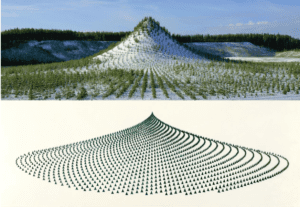
Wheatfield—a Confrontation by Agnes Denes (also pictured), 1982.
Courtesy of the Public Art Fund, New York. Photo by John McGrail.
Purpose has been hung out to dry, in adland anyway. A few years ago, brands were clamouring to proclaim their purpose-driven brand mission. Profit, oh no, we’re too right on for that. Weirdly punters saw through the falsehoods of much of the frontage. Humans, it turns out, can spot claptrap instinctively. But, but. There is merit in the pursuit. Creatives have great ideas. Brands have budgets. It might be just about making sure the purpose actually serves real people, and not the agency’s ego-cabinet. Look at this here example. Sure, Agnes Denes is an artist. It’s sacrilege to even mix her up in this. But it shows the power of ideas. Acres of grain. Planted on valuable real estate. Lady Liberty punching the air. And you call it Wheatfield – A Confrontation. After the harvest the seeds went to the public, the hay to NYC Police horses.

Tree Mountain—A Living Time Capsule—11,000 Trees—11,000 People—400 Years (triptych) by Agnes Denes, 1992 – 1996. Courtesy of the artist and Leslie Tonkonow Artworks + Projects
Then, in 1992, she created Tree Mountain, 11,000 people, 11,000 trees – 4 months. It’s pretty. It makes an impression. And it provides a natural water filter, flood protection, and a nice habitat for the earth’s other beings. But she’s not selling anything, or working for (apologies in collaboration with) wheaty puff morning cereal, or ‘under the tree at Spar’ you say. Totally. But, if she was, would it be so bad. If human purpose and brand purpose can actually unite to benefit and create value, boosting profits because people start seeing themselves and align with a brand that is doing more than fluff pieces, is that not showing how creativity is fundamentally beneficial to commerce.